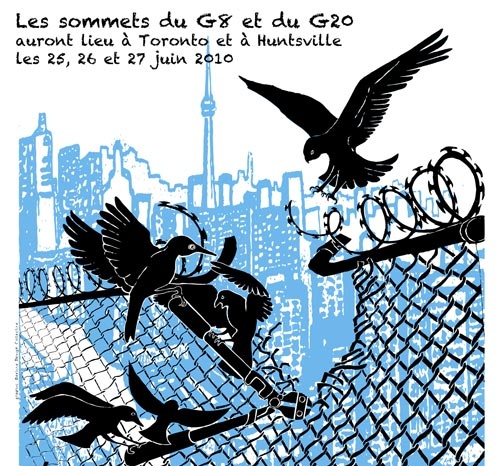 |
 |
 |
 |
 |
 |
|
 |
 |
 |
 |
 |
 |
 |
Régions du Québec |  |
 |
 |
|
 |
 |
|
 |
 |
|
 |
 |
 |
 |
 |
 |
Rubriques (sujets) |  |
 |
 |
|
 |
 |
|
 |
|
 |
 |
 |
South Ossetia: Fulcrum of Imperialism’s “Great Game”
In this historical period the contortions of capital can only mean more and more attacks on the living conditions of the proletariat; they can only create poverty and hunger for hundreds of millions of human beings, that is when they are not pummelling them with their armed tanks. Devastation as a result of armed conflict wherever the essential interests of capital are threatened: this is the necessary condition for maintaining an economic form based on profit and exploitation.
Montreal internationalist communists havin't any organisational links with the International Bureau of the Revolutionary Party (IBRP) and don't agree with all its political positions. As well we've published the text below from International Bureau for the Revolutionary Party (IBRP) because it's important for our class.
Some internationalist communists, Montreal
cim_...@yahoo.com
South Ossetia: Fulcrum of Imperialism’s “Great Game”
Since 1992 the question of Ossetia has troubled the Caucasus. Along with every other nationalism, Ossetian nationalism is part of an imperialist game that is being made increasingly difficult by the international crisis. The motive forces which have induced Georgia to attack the small autonomous region in the Caucasus and those which have impelled Russia to employ its army in favour of the Ossetian secessionists against the Tbilisi government lie well beyond what the immediate tale of local events would tell us.
First of all the Ossetian question involves the struggle between Russia and Georgia. The former cannot tolerate the Saakashvili government moving closer towards the United States, much less its declared aim to become part of Nato as a pawn of Washington in the area of the ex-soviet empire. That, along with Ukraine, would comprise an anti-Russian front along the mid-southern border. The latter, Georgia, wants to accelerate its “westernisation” by this recent act of force where it has explicitly called for US intervention. Thus it hopes to resolve the Ossetian matter in its favour, to put down the accomplished facts in front of the Russian enemy and to win recognition as the future bridgehead for western interests in the Caucasus, with all the political and economic advantages that the new status would confer. Specifically, the conflict with South Ossetia could open the door to US interests which, in the shape of the Georgia of Saakashvili, would bypass existing Russian control and give the US unique sway over the control and transport of the energy riches of the Caspian.
For this reason the conflict between Russia and Georgia (USA) is centred round the necessity, on the part of both of them, to control the countries which are either close to or adjoining the west bank of the Black Sea (North Ossetia, but also Daghestan). The area is important for the passage of future oil and gas lines which will carry raw energy to Europe and the course of which necessitates the exclusion of any form of interference from competition. Russia plans to construct, with huge investments, a gas pipeline (south stream) which would be able to carry gas to Europe from the Caspian via the Black Sea and with two terminals, one in the southern zone (Greece, Kosovo or Puglia); the other further north towards Austria. But the critical point of the project rests on the East bank of the Black Sea: in South Ossetia or else Daghestan. The projected plan is for part of the gas pipeline — the piece that goes from Vladikavkaz (North Ossetia) to the edge of Tskhinvali — to pass completely through South Ossetian territory in order to then turn towards Russia’s Black Sea ports.
And this is where the conflict ceases to be regional and assumes the dimensions of an inter-imperialist conflict which leads to Russia and the United States, with their objective of achieving hegemony in the area, putting pressure on allies, punishing adversaries, inciting aggression and military responses with the single aim of creating the best conditions for achieving their own respective interests. It’s not for nothing that Georgia’s military action has had American support — remember that the US government used its own aeroplanes to transport a military contingent of 2,000 Georgian soldiers from Afghanistan directly to south Ossetia — and how the Russian response was immediate, planned and violent to the point of hysteria.
In the third place the tragic events of Ossetia confirm that:
1- In the imperialist epoch every kind of demand for national rights, whether real or assumed, spontaneous or artificially provoked, under whatever political banner and goals it sets itself, it will end up being absorbed into the inter-imperialist struggle with no possibility of playing an autonomous role other than serving as a means for the local bourgeoisie to pursue their own interests and as part of an imperialist line-up.
2-The devastating economic crisis which is running through the capitalist world exacerbates competition and the potential for conflict in all the international markets, from the financial markets to the markets for strategic raw materials, and does not exclude the use of force.
3- In the same way, the margins for defining so-called regional crises are reduced to zero and every contentious issue is ‘resolved’ by means of force. More than ever warfare has become the instrument imperialism uses when it attempts to resolve its problems.
In this historical period the contortions of capital can only mean more and more attacks on the living conditions of the proletariat; they can only create poverty and hunger for hundreds of millions of human beings, that is when they are not pummelling them with their armed tanks. Devastation as a result of armed conflict wherever the essential interests of capital are threatened: this is the necessary condition for maintaining an economic form based on profit and exploitation.
The events in tiny South Ossetia are the tragic manifestation of this barbaric world from which there can be no escape except by a powerful resurgence of the class struggle.
Fabio Damen 2008-08-12
 |
 |
 |
 |
Dossier G20 |  |
 |
 |
|
 |
 |
|
 |
Nous vous offrons plusieurs reportages indépendants et témoignages...

Liste des activités lors de ce « contre-sommet » à Toronto Vous pouvez aussi visiter ces médias alternatifs anglophones... Centre des médias Alternatifs Toronto 2010.mediacoop.net Media Co-op Toronto http://toronto.mediacoop.ca Toronto Community Mobilization www.attacktheroots.net (en Anglais) |
 |
 |
 |
 |
 |
 |
 |
CMAQ: Vie associative |  |
 |
 |
|
 |
 |
|
 |
 Collectif à Québec: n'existe plus. Impliquez-vous ! |
 |
 |
 |
 |
 |
 |
 |
 |
|
 |
 |
 |
Ceci est un média alternatif de publication ouverte. Le collectif CMAQ, qui gère la validation des contributions sur le Indymedia-Québec, n'endosse aucunement les propos et ne juge pas de la véracité des informations. Ce sont les commentaires des Internautes, comme vous, qui servent à évaluer la qualité de l'information. Nous avons néanmoins une
Politique éditoriale
, qui essentiellement demande que les contributions portent sur une question d'émancipation et ne proviennent pas de médias commerciaux.
This is an alternative media using open publishing. The CMAQ collective, who validates the posts submitted on the Indymedia-Quebec, does not endorse in any way the opinions and statements and does not judge if the information is correct or true. The quality of the information is evaluated by the comments from Internet surfers, like yourself. We nonetheless have an
Editorial Policy
, which essentially requires that posts be related to questions of emancipation and does not come from a commercial media.


